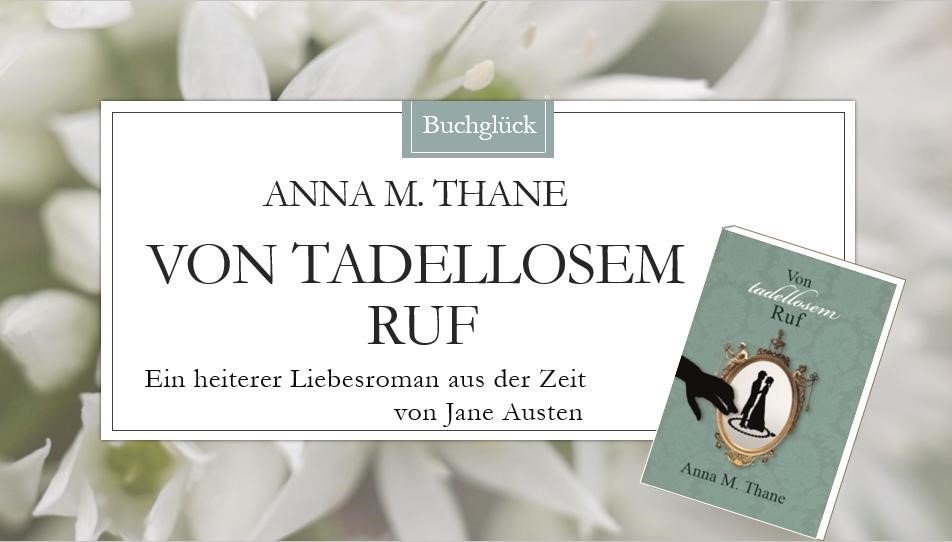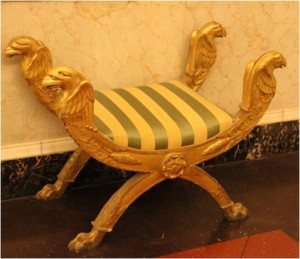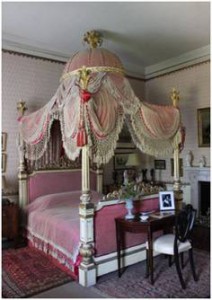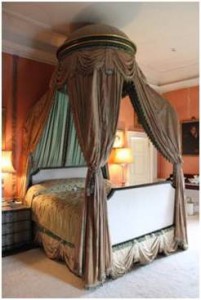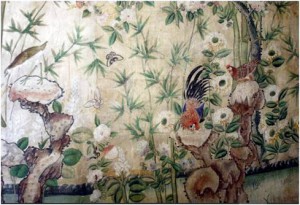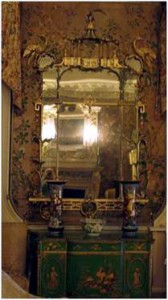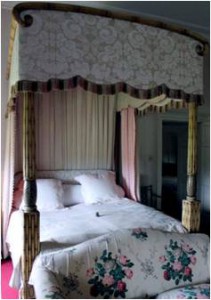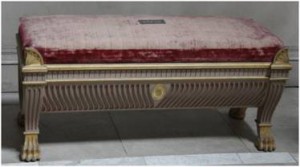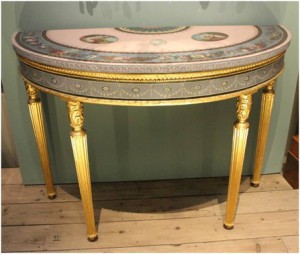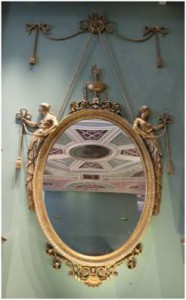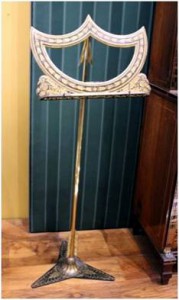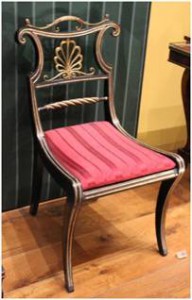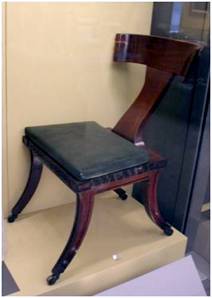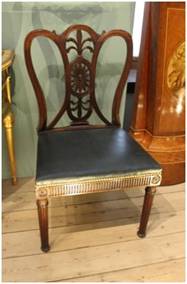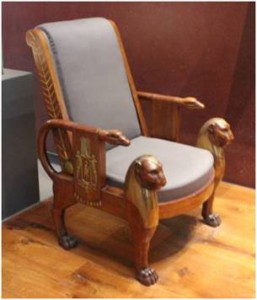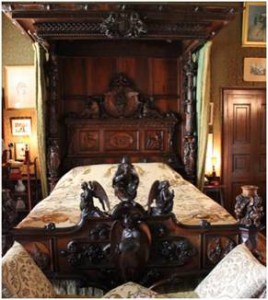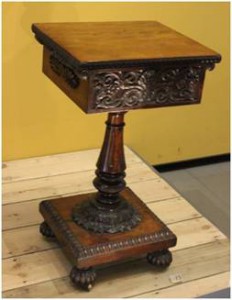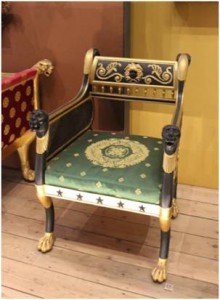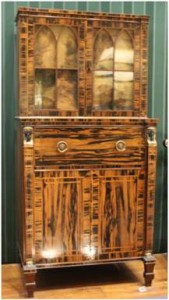The Romantic Age saw a quick succession of trends in furniture fashion. These trends had one thing in common: They were inspired by foreign cultures, and often sparked by exploration and discoveries.
Travelling was expensive. Doing the Grand Tour to see the art treasures of France and Italy was only for the rich. Decorating a room with furniture in the style of the ancient Greek and Roman civilisations demonstrated wealth and education. Later in the age, wars and the Continental Blockade put a stop to private travelling. Nevertheless, furniture inspired by distant countries brought an exotic touch to the home.
Which style was fashionable in which decade of the Romantic Age? When would the hero of a Regency novel buy furniture inspired by the Egyptian culture? Would the heroine be likely to sleep in a lit à la polonais in 1812? Here is a small, chronological exhibition to answer these questions.
Louis XV Style with a Polish Twist (1750-1780)
The lit à la polonais, i.e. bed in Polish style, was the most popular model of beds in 18th century France. The trend had been inspired by Maria Leszczyńska, the wife of Louis XV and daughter of King Stanisław I of Poland. The lit à la polonaise was fashionable in England from about 1750 to 1780. It would have mainly been associated with Louis VX and the court in France.
The special feature of the lit à la polonais was the dome with its canopy. The canopy was smaller than the surface of the bed. Rich fabric such as silk and damask flowed from it, creating the tent-like impression. The dome roofing the bed was held by curved iron bars. A bunch of feathers ornamented the centre and each of the corners of the canopy.
The Polish bed fell out of fashion with the French revolution.
Chinoiserie (1760 – 1830)
Furniture inspired by China first appeared in the 17th century. It became popular in the 18th century due to the rise in trade with China and East Asia. Its main proponent was the Prince of Wales, who often gave Chinese wallpapers as a gift to his friends.
Typical for Chinoiserie furniture was a lacquerwork finish, the use of motifs such as wing pagodas and dragons, and the imitation of bamboo wood.
The delicate and light Chinoiserie decoration was usually found in bedrooms and dressing rooms. Being private spaces, these rooms were associated with women. Reception rooms, dining rooms or libraries were public spaces associated with men or mixed company. Here, the neo-classical style would prevail.
With the death of King George IV in 1830, Chinoiserie declined in popularity.
Neo-classical or Grecian / Etruscan Style (1760-1820)
From about 1760, the Neo-classical style swept away the Rococo style of the mid Georgian era. It was sparked by a renewed interest in the classical civilisations of Greece and Rome, and the excavations at Pompeii and Herculaneum in the Kingdom of Naples.
By 1775, the neo-classical style was the most popular furniture style in Britain. Its celebrated designers were Robert Adam, George Hepplewhite, and Thomas Sheraton.
Typical for neo-classical furniture were straight, harmonious lines, and the use of ornaments such as urnes, phiales, winged griffins, fluting, acanthus leaves, etc. The wood of choice was mahogany.
In the later period of the neo-classical style, the furniture design became simpler and less ornate. Furniture designers attempted to make actual copies of ancient furniture, instead of designing pieces according to their own idea of the ancient civilizations.
A typical feature was brass work with ornamental design. Typical pieces of this period were chairs with legs curving forwards (called “sabre”), and the “klismos” chair of ancient Greek design.
The Neo-classical style fell from favour in the 1820ies, when neo-gothic designs became popular in the wake of a renewed interest in the medieval period.
Egyptian Style (1800 – 1820)
From around 1800, an interest for all things Egyptian gripped the country. The craze was fuelled by Napoleon’s conquest of Egypt in 1797 and Admiral Nelson’s victory of the Battle of the Nile in 1798.
Furniture in Egyptian style was adorned with motifs of ancient Egypt. Typical materials were brass ornaments, and dark wood such as rosewood and zebrawood.
Neo-Gothic Style (1820 – Victorian Age)
Neo-Gothic style furniture became popular during the Regency as an alternative to neo-classicism.
By the end of this period, furniture fashion had taken on political connotation: the neo-classical style had become negatively associated with republicanism and liberalism. These had been the ideals of the political forces that had sympathised with the enemy – America and Republican France – during the decades of war. The neo-Gothic style, on the other hand, had become associated with monarchism and conservatism.
Additionally, the industrial revolution took up pace, and many people felt uncomfortable with mass production and the spread of factories. For them, the pre-industrial medieval society became a new ideal. Furniture designers echoed the need for an old-fashioned comfort zone by designing furniture in medieval style.
Eclectic Style (1820 – Victorian Age)
With the progression of the Regency period, the furniture designers began to mix the fashion trends. Elements from different time periods and different origins were combined in a single piece of furniture. Furniture could be part gothic, part Egyptian, and part Grecian, etc. The eclectic style flourished from the late 1820ies continued throughout the Victorian Age.
Photos: Armchair in Roman-Egyption, 1804 (V&A) / Gothic-Egyptian bookcase, 1808 -1810 (V&A )
Sources
Singleton, Esther/ Nicols, H.D.: French and English furniture. Distinctive styles and periods described and illustrated; McClure Phillips & Co, 1903
Miller, Judith: Miller’s Antiques Encyclopedia, Octopus Publishing Group, 2008
Furniture Styles: Regency furniture: http://www.furniturestyles.net/european/english/regency.html
Victoria and Albert Museum, Cromwell Rd, London SW7 2RL, UK; Link: http://www.vam.ac.uk/
Article by Anna M. Thane, author of the novel
“Von tadellosem Ruf” (http://amzn.to/2TXvrez)
